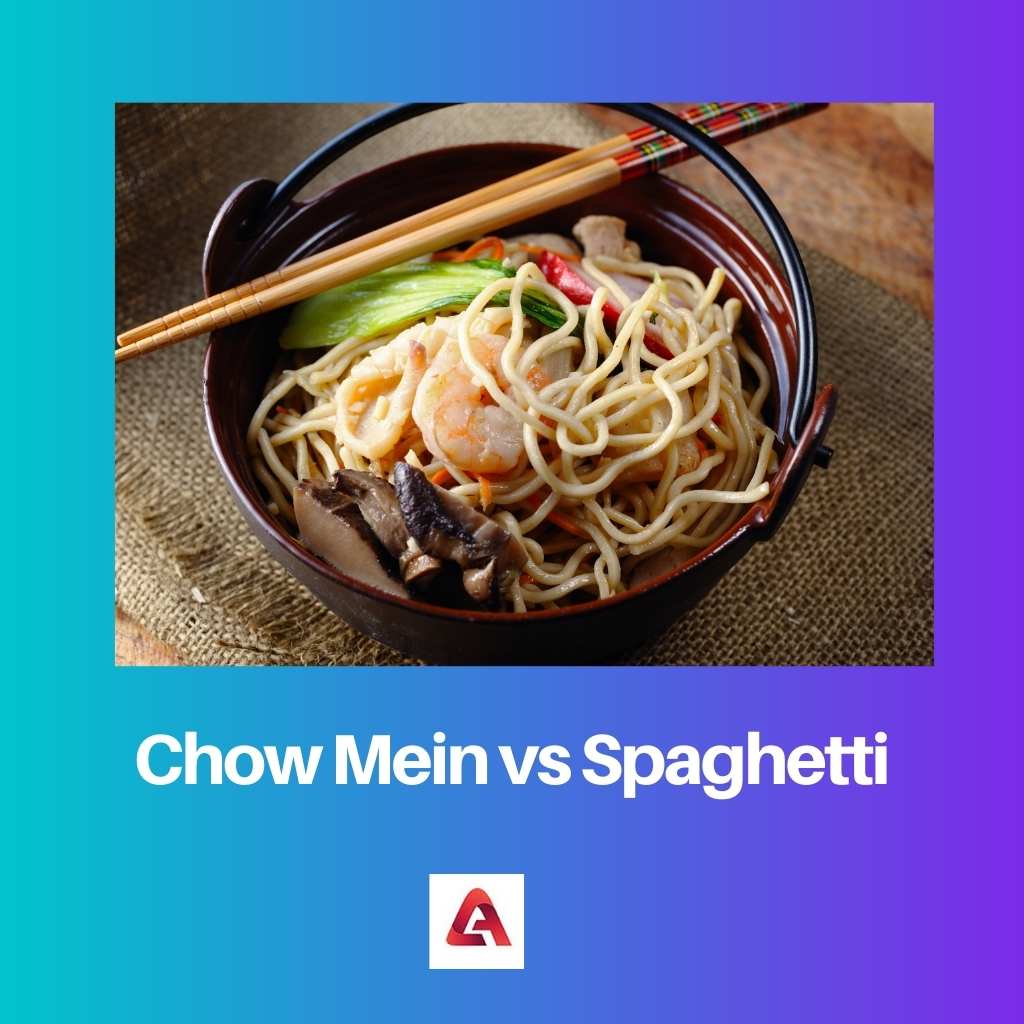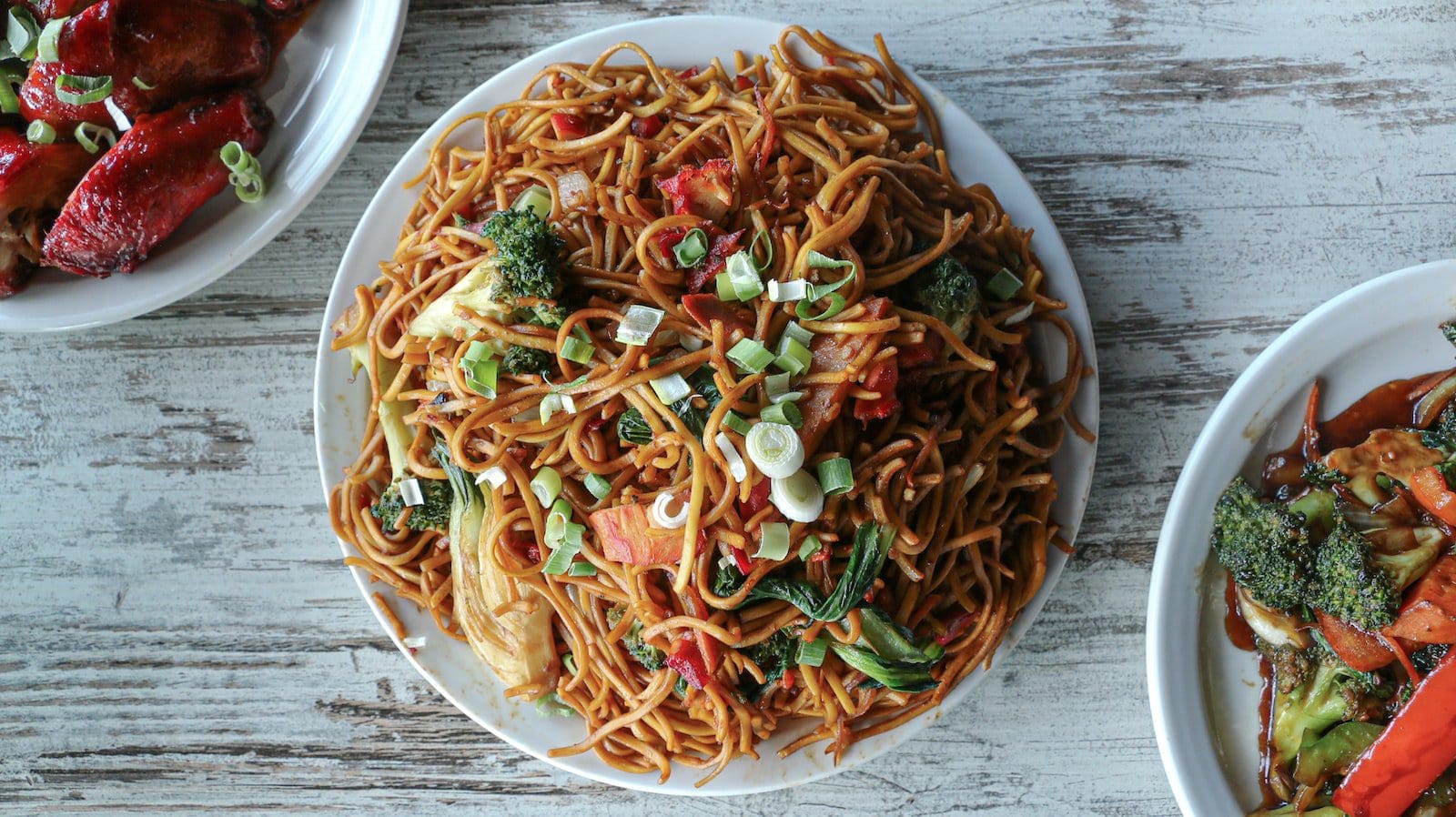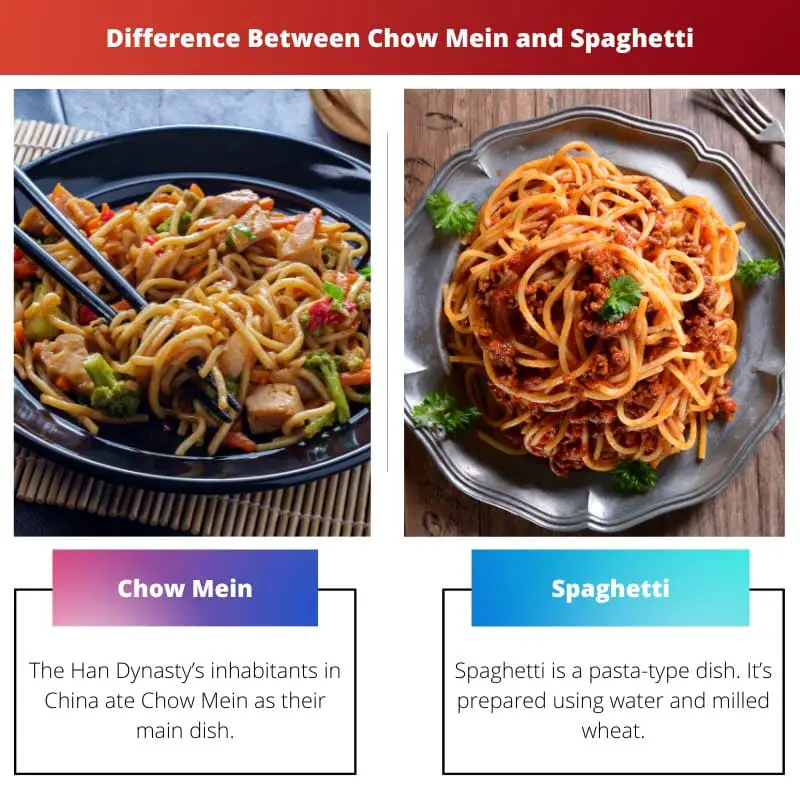Chow Mein & spaghetti are both common foods that are eaten all around the world. In many regions of the world, both are stapled meals.
Chow Mein is thinner than spaghetti, even though they are both long and cylindrical. People frequently mistakenly believe these are the same food items, although they are not.
Key Takeaways
- Chow Mein is a Chinese dish made with stir-fried noodles and vegetables, while spaghetti is an Italian dish with boiled pasta and tomato sauce.
- Chow Mein noodles are thinner and softer than spaghetti noodles, which are thicker and firmer.
- Chow Mein includes soy sauce, ginger, and garlic, while spaghetti sauce includes tomatoes, basil, and garlic.
Chow Mein vs Spaghetti
Chow mein is a Chinese dish consisting of stir-fried noodles with vegetables and meat,. Spaghetti is a long, thin, cylindrical pasta of Italian origin, served with a variety of sauces and ingredients such as tomato sauce, meat, and vegetables.

The Han Dynasty’s inhabitants in China ate Chow Mein as their main dish. It swiftly gained popularity in Asia, Europe, as well as the Middle East.
It’s made using flour, egg, and water in an unleavened dough. The dough can be made into a variety of shapes and sizes for the noodles. They are thinner from spaghetti and thus are eaten with chopsticks.
Spaghetti is a pasta-type dish. It’s prepared using water and milled wheat. Durum wheat semolina is used to make Italian spaghetti. Other varieties of flour, such as multigrain or whole wheat, may be used in some areas.
Spaghetti comes in a variety of shapes and sizes, including Spaghettini and Spaghettoni. Spaghettini, called angel hairs spaghetti, is thinner than Spaghettoni, thus it cooks faster. Because the Spaghettoni has a large diameter, it takes longer to cook.
Comparison Table
| Parameters of Comparison | Chow Mein | Spaghetti |
| Origin | China | Italy |
| Shape | Comes in a variety of shapes and sizes | Long and cylindrical |
| Made of | It’s created using unleavened dough (flour, egg, & water) and cooked in a pot of boiling water and oil. | It’s created with semolina as well as flour & cooked with salt plus oil in boiling water. |
| Tradition dish | Many countries | Only in Italy |
| Served | Served in many ways, could be fried with veggies and meat. | Spaghetti is served with sauce. |
What is Chow Mein?
Chow mein is a Chinese dish consisting of stir-fried noodles with veggies and, on occasion, pork or tofu. Chao-mian has evolved over the years in different parts of China; there are several ways to fry the noodles and a variety of toppings to choose from.
Chinese immigrants introduced it to other countries. The dish is mainly popular in Chinese diaspora and can be found on the menus of every Chinese restaurant in the world.
The softer texture of steamed chow mein contrasts with the crispier and drier texture of the latter. Crispy chow mein is either completed with onions and celery or served “strained,” without any veggies.
Steamed chow mein can be made with a variety of vegetables, the most frequent of which being onions and celery, but carrots, cabbage, as well as mung bean sprouts can also be used.
Steamed chow mein is blended with soy sauce before being served, whereas crispy chow mein is frequently covered with a rich brown sauce. In the United States, the terms “chow mein” are used differently on the East & West coasts.
Mostly on East Coast, “chow mein” means “crispy noodles.” Crunchy chow mein are deep-fried at some eateries in those places, and they can be crispy “such as the ones inside cans” or “fried as crisp as hash browns.”
In some areas Chow mein is also offered over rice in a few East Coast restaurants.

| # | Preview | Product | |
|---|---|---|---|
| 1 |

| Nissin Chow Mein Noodles, Teriyaki Beef, 4 Ounce (Pack of 8) | Check Price on Amazon |
| 2 |

| La Choy Chow Mein Noodles, 5 oz | Check Price on Amazon |
What is Spaghetti?
Spaghetti is a cylindrical, long, thin, firm pasta. It’s a common dish in traditional Italian cooking. Spaghetti, like other pasta, is manufactured from milled wheat and water and is sometimes supplemented with vitamins & minerals.
Durum wheat semolina is used to make Italian spaghetti. While refined flour is being used, the pasta is white, however, whole wheat flour can be used. Spaghetti is divided into two types: thicker spaghettoni and thinner capellini.
Spaghetti used to be very long, but in the second half of the twentieth century, shorter lengths became more popular, and it is now most available in approximately 30 cm lengths.
It’s the basis for several pasta recipes, and it’s eaten with tomato sauce, meat, or vegetables.
Imitation spaghetti could be made with just a rolled pin and just a knife at its most basic level. A homemade pasta machine makes rolling and cutting easier and more consistent.
Cutting sheets, on the other hand, make pasta with a rectangle shape rather than a cylindrical cross-section, resulting in a fettuccine variety.
Some pasta machines come with a spaghetti attachment that has circular holes for extruding spaghetti or curved rollers for making cylindrical noodles.
Spaghetti can be prepared by hand by stretching a dough ball into a long sausage shape on a surface. To form a long thin sausage, the ends of the sausage are stretched apart.

Main Differences Between Chow Mein and Spaghetti
- Spaghetti is a form of pasta that is thought to have originated in Italy, whereas Chow Mein originated in China.
- Spaghetti is long, thin, and cylindrical, but Chow Mein comes in a variety of shapes and sizes.
- Spaghetti is prepared of semolina and flour then cooked in boiling water with salt and oil, whereas Chow Mein is prepared of flour dough (flour, egg, & water) then cooked in hot water and oil.
- Chow Mein is prepared in a variety of ways around the world, for example, it can be cooked with veggies, meat, or other ingredients, whereas spaghetti is served with sauce.
- Chow Mein is best eaten with chopsticks, while spaghetti is best eaten with a fork.






